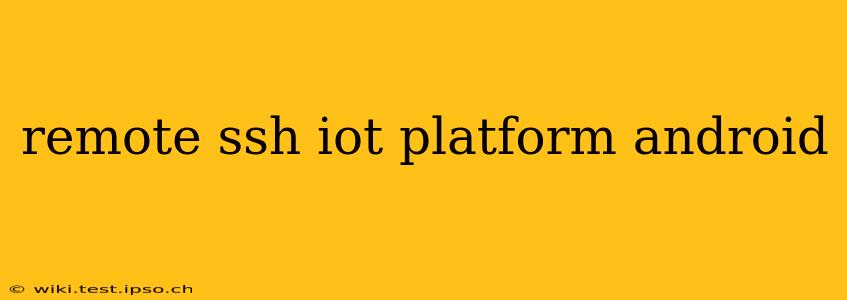The Internet of Things (IoT) is rapidly expanding, connecting everyday devices to the internet. Managing and controlling these devices often requires remote access, and Secure Shell (SSH) is a robust and secure method for achieving this. This article explores how to establish a remote SSH connection to your IoT devices using an Android platform. We’ll cover the essentials, security best practices, and answer common questions.
What is an SSH IoT Platform?
An SSH IoT platform facilitates remote management and control of IoT devices through secure SSH connections. It allows users to execute commands, monitor device status, transfer files, and perform other administrative tasks, all from the convenience of an Android device. The security inherent in SSH protocols makes it ideal for managing sensitive IoT devices and data.
How to Set up Remote SSH Access on Your IoT Device
Before you can connect from your Android device, you need to enable SSH access on your IoT device. This process varies depending on the device's operating system (e.g., Linux, embedded systems) and configuration. Generally, it involves installing an SSH server (like OpenSSH) and configuring it appropriately. This includes setting up user accounts, defining access permissions, and potentially configuring firewall rules to allow SSH connections on a specific port (usually port 22, but this can be changed for added security). Consult your IoT device's documentation for specific instructions.
Connecting to Your IoT Device via SSH from Android
Several Android apps provide SSH client functionality. These apps allow you to establish a secure connection to your IoT device, providing a terminal interface for interacting with it. Popular options include:
- JuiceSSH: A user-friendly app with features like tabbed sessions, key management, and SFTP support.
- ConnectBot: A powerful and versatile SSH client known for its simplicity and stability.
- Termux: A terminal emulator that can be used with an SSH client. It offers a more advanced environment but requires a steeper learning curve.
The process typically involves entering the IP address or hostname of your IoT device, your username, and your password (or using SSH keys for enhanced security). After a successful connection, you'll have access to a command-line interface where you can execute commands to manage your device.
What apps are needed to access my IoT device remotely via SSH on Android?
As mentioned above, several Android apps provide SSH client functionality. JuiceSSH, ConnectBot, and Termux are popular choices, each offering varying levels of functionality and user experience. The best choice depends on your technical proficiency and specific requirements.
Can I use SSH keys for enhanced security?
Yes, using SSH keys is strongly recommended for enhanced security. SSH keys eliminate the need to enter passwords, significantly reducing the risk of unauthorized access. You'll need to generate a key pair (public and private) on your computer, upload the public key to your IoT device, and use the private key on your Android app to authenticate. Most SSH clients mentioned above support SSH key authentication.
What are the security considerations for remote SSH access to IoT devices?
Security is paramount when managing IoT devices remotely. Here are some key considerations:
- Strong Passwords/SSH Keys: Utilize strong, unique passwords or SSH keys.
- Firewall Configuration: Properly configure your firewall to allow SSH connections only from trusted sources or IP addresses.
- Regular Updates: Keep both your IoT device's operating system and your Android SSH client up to date with security patches.
- Port Forwarding (if needed): If your IoT device is behind a NAT router, you'll need to configure port forwarding to allow external access to the SSH port.
- Two-Factor Authentication (2FA): If your SSH server supports it, enable 2FA for an extra layer of security.
How do I troubleshoot SSH connection issues?
Troubleshooting SSH connection issues often involves verifying the following:
- Network Connectivity: Ensure your Android device and IoT device are connected to the network and can communicate with each other.
- IP Address/Hostname: Double-check the IP address or hostname of your IoT device.
- SSH Server Status: Ensure the SSH server is running on your IoT device.
- Firewall Rules: Verify your firewall rules aren't blocking SSH connections.
- Port Forwarding (if applicable): Ensure port forwarding is configured correctly.
- SSH Client Configuration: Check your Android SSH client's settings to make sure they are correctly configured.
By following these guidelines and choosing a suitable SSH client, you can securely manage and control your IoT devices remotely using your Android device. Remember to prioritize security at every step to protect your data and devices from unauthorized access.
